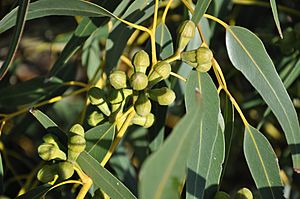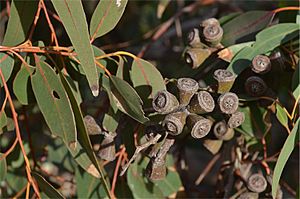Tuart facts for kids
Quick facts for kids Tuart |
|
|---|---|
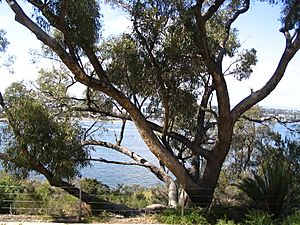 |
|
| A Tuart tree in Kings Park, Perth | |
| Scientific classification | |
| Genus: |
Eucalyptus
|
| Species: |
gomphocephala
|
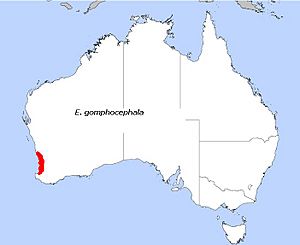 |
|
| Where Tuart trees grow | |
| Synonyms | |
|
|
The Tuart (scientific name: Eucalyptus gomphocephala) is a very large tree found in Southwest Australia. It is one of the six "forest giants" of this region. Tuart forests used to cover much of the Swan Coastal Plain. However, many of these valuable trees were cut down for wood or removed for city growth around Perth.
Tuart wood is very strong and can resist water. It also does not splinter easily. This made it very useful in the past. Today, you can still find Tuart trees in special parks and nature reserves. Sometimes, they have been planted in other parts of Australia and even in other countries. These trees can get sick from a disease called dieback, which can kill them.
Contents
About the Tuart Tree
What Does a Tuart Tree Look Like?
Tuart trees are native to the southwest part of Western Australia. They usually grow between 10 and 40 meters (33 to 131 feet) tall. The tallest known Tuart tree is 47 meters (154 feet) high. It is located in the Tuart Forest National Park near Ludlow. The largest Tuart tree has a wood volume of 108 cubic meters (3,814 cubic feet). Taller trees are often found in the southern parts of their range. Smaller trees are found more to the north. The top part of the tree, called the crown, can spread up to 25 meters (82 feet) wide.
Tuart trees usually have a single tall trunk. But sometimes, if they are near salty areas or strong winds, they might grow shorter with many stems.
Bark, Leaves, and Flowers
The Tuart tree has rough, box-like bark along its trunk and branches. The bark is fibrous and grey. It breaks off in small, flaky pieces. Its leaves have stalks and are shaped like a spear or a sickle. They are slightly different shades of green on each side or the same color. They are glossy, light green, and thin. Each leaf blade is about 90 to 160 millimeters (3.5 to 6.3 inches) long and often curved.
White flowers appear from mid-summer to mid-autumn, usually between January and April. The flower buds grow in clusters of seven. These buds have swollen caps that look like small ice cream cones. They are about 8 to 10 millimeters (0.3 to 0.4 inches) long. The flowers form in tight groups. After flowering, they turn into mushroom-shaped fruits. These fruits contain small red-brown seeds. The fruits are narrow, 13 to 25 millimeters (0.5 to 1 inch) long, and have a wide rim.
How Tuart Trees Got Their Name
The botanist Augustin Pyramus de Candolle first officially described the Tuart tree in 1828. He published his description in a book called Prodromus Systematis Naturalis Regni Vegetabilis. The first samples of the tree were collected by botanist Jean-Baptiste Leschenault in 1802. This was during the Baudin expedition to Australia.
The name gomphocephala comes from two Greek words: gomphos, meaning 'club', and kephale, meaning 'head'. This describes the rounded, overlapping shape of the flower cap.
The Noongar Aboriginal people, who are the traditional owners of the land where Tuart grows, called the tree tuart, tooart, moorun, or mouarn.
Where Tuart Trees Grow
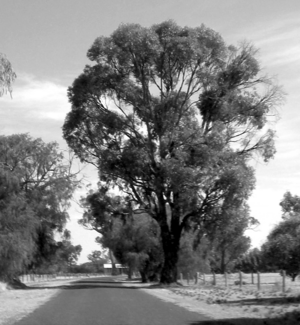
Tuart trees grow in a narrow strip along the coast of the Swan Coastal Plain. This area stretches about 5 to 10 kilometers (3 to 6 miles) inland. It goes from Yanchep in the north down to Busselton in the south.
When the Swan River Colony was settled, much of this land was cleared for farming and then for cities. This greatly reduced the number of Tuart trees and forests. Some small groups of Tuart trees can be found further north, up to Geraldton. They also grow further inland where rivers cross their usual range. Tuart trees have also started growing naturally in other places.
These trees prefer sandy, well-drained soils, often over limestone. They need sunny spots to grow well. Tuart trees are part of coastal shrubland ecosystems in areas with deep sand. They also grow in small woodland areas that are protected along the coast. In woodlands, they often grow with peppermint trees (Agonis flexuosa).
Uses of Tuart Wood
Tuart wood is a very strong hardwood. It has been used for many things, like building railway carriages and boats. Its beautiful color and grain pattern also make it popular for furniture. Because so many trees were cut down, Tuart is now a protected tree. There are rules about when and how it can be cut.
The inner wood, called heartwood, is a pale yellow-brown color. It has a fine texture and a very twisted, almost curled, grain. Freshly cut wood is very dense. Even when air-dried, it remains very heavy.
Tuart flowers are also an excellent source for making honey. The honey is light and creamy. It can crystallize quickly if it is properly matured in the hive. In the past, Tuart honey was considered very high quality.
Tuart Tree Ecology
Tuart trees can handle some salty soil and winds that carry salt. They are also good at surviving droughts and frost. Individual Tuart trees can live for more than 400 years.
Experiments in the 1930s showed that Tuart trees could grow in areas with very little rainfall. They were even brought to France and widely grown there by the late 1800s.
Tuart forests are home to many different kinds of plants, fungi, and animals. This makes them very rich in biodiversity. Scientists have studied the fungi that live inside Tuart trees and other plants in these woodlands. They found many types of fungi, including some new ones.
The Tuart tree is so important that it gives its name to a special ecological community. This community is called "Tuart (Eucalyptus gomphocephala) woodlands and forests of the Swan Coastal Plain." These woodlands have become much smaller and are broken into many pieces. In 2017, it was suggested that these woodlands should be listed as critically endangered. This means they are at very high risk of disappearing.
Tuart trees are also at risk from dieback, a disease caused by certain fungi. In 2007, a new species of fungus, Phytophthora multivora, was found in sick or dead Tuart trees. This fungus contributes to the dieback disease.
A native insect called the tuart bud weevil can also damage the trees. The female weevil lays a single egg in the flowers. The larvae then eat the flower parts, which can damage or destroy the bud.
Tuart forests have been around for a very long time, even through the last ice age. They survived because the ocean helped keep the climate milder. This was important during times when other parts of Australia became very dry.
History of Tuart Trees
The amount and age of Tuart forests greatly decreased after European settlement. Early explorers like Charles Fraser were amazed by their huge size. One explorer, Drummond, found trees between 9 and 13 meters (30 and 43 feet) around in a forest north of Busselton.
The wood from the first sawmill in the colony, located in a Tuart forest at Kings Park, was used to build government buildings. People noted that Tuart wood was strong but easy to work with. The large wooden gears at the Old Mill in Perth, weighing four tons, were made from Tuart wood.
The British Navy even received shipments of Tuart timber in the 1850s and 1860s. It was sent from Wonnerup and Bunbury because it was so strong and did not split easily. There was even a plan to send a 4-meter (13-foot) wide Tuart log to the Great Exhibition in 1851, but they couldn't find a saw big enough to cut it.
The fact that these forests were close to ports made the timber even more valuable. In the 1890s, the land cleared from Tuart forests was used to plant fruit orchards.
In the early 1900s, Tuart wood from state forests was used for railway carriages. This saved money because it replaced steel. The wood was only available in small amounts for private uses, like stair treads and butcher's blocks.
In 1882, a survey showed that Tuart forests covered about 130,000 hectares (320,000 acres). The first road from the port to the capital passed through what was called Claremont Tuart Forest. By 1895, the first state forest conservator, John Ednie Brown, reported that only 81,000 hectares (200,000 acres) of Tuart forest remained. He was impressed by the tall, straight trees, some up to 50 meters (164 feet) high.
By 1903-04, a Royal Commission on Forestry reported that only just over 40,000 hectares (99,000 acres) were left. They said that "prime trees" (those over 0.8 meters in diameter) were hard to find. The commission suggested protecting Tuart, calling it "the most valuable tree." This led to rules that limited the export of Tuart wood, mainly to keep it for the state's railway system.
In 1918, a law was passed to protect forests. The state conservator, Charles Lane Poole, suggested buying a 400-hectare (990-acre) area near Wonnerup. This area, State Forest No. 1, was called "the last remaining virgin tuart in the world." By 1922, the State Forest grew to about 2,500 hectares (6,200 acres). The state sawmill that supplied the railway operated in this forest until 1929.
By the early 21st century, most Tuart forests had been cut down or cleared. What remains is decreasing in diversity and health.
Images for kids
See also
 In Spanish: Árbol tuart para niños
In Spanish: Árbol tuart para niños


